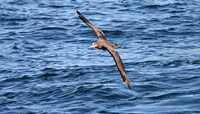

 | |||||||||||||||
|
|
Journals 2008/2009Heather Judkins
August 9, 2008 I haven't written about the fascinating feathered friends that have been flying about the ship for two weeks so I will give some details in this entry. At this point in the cruise, we are the furthest offshore that we will be. Our trackline will slowly bring us back towards the continental shelf break and coasts as the cruise nears its end. The birds this week have been few and far between but the ones we have seen have been quite interesting. The black-footed albatross is a new species for me and it is beautiful to watch glide over the water. This pelagic bird is found year round in the California current and nests in the Hawaiian Islands. This bird can have an 84-inch wingspan and can weigh up to seven pounds. It feeds mainly on squid and flies solo most of the time. A couple of them were following the ship yesterday while they were scoping out lunch.
There are a couple of birds that we have seen that do not belong this far out in the ocean-the brown headed cowbird and the upland sandpiper. These birds have strayed from their normal migration paths and may not make it back to their proper destinations.
The brown-headed cowbird is common in open or patchy woodlands and eats seeds and small invertebrates from the ground. I found out that they are brood parasites, which means they lay their eggs in other birds nests and those adult birds raise the chicks. They are found year round in the southern half of the United States as well as along the west coast. Needless to say, there aren't any woodlands on the ship so this little juvenile is drastically off course. This bird stayed on/around the ship for a couple of days before continuing on his wayward journey. The upland sandpiper is found east of the Rockies in the grassy fields of the mid west US, and migrates to the south as far as Argentina during the year. This species in declining in the grasslands due to habitat loss. It is rarely found along the western half of the US at any time. So, to find this animal out 200 miles in the Pacific is quite a sight. Question 1: What is the largest Albatross species? Will I see one during my journey? Question 2: Do we see the Upland sandpiper in Florida at any point in the year? What species of sandpipers are there in our area? |
||||||||||||||


